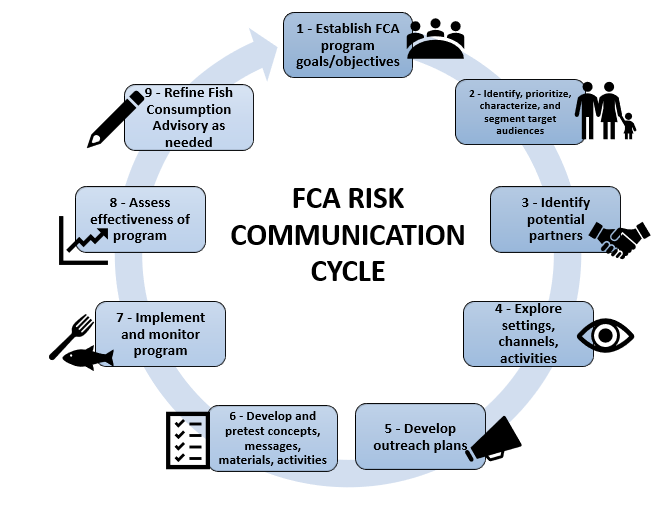9 - Evaluation and Refining Fish Consumption Advisory As Needed
The ninth step for developing and implementing a risk communication program for fish and shellfish consumption advisories is to evaluate and refine the fish consumption advisory (FCA) as needed.
There are reasons to refine the risk communication aspects of a FCA, for example new fish sampling data and/or scientific evidence indicating it is safe to eat more or less of a certain species of fish or evaluation data showing that the FCA is not effective.
This is a four-volume guidance. Volumes 1-3 provide guidance for assessing health risks associated with the consumption of contaminated non-commercial fish. EPA encourages that these three volumes be used with these new webpages on risk communication for FCAs, since no single volume addresses all the topics involved in the development and implementation of FCAs.
Refining the FCA Outreach Plan
The FCA risk communication process is cyclical. Review the evaluation report and consider the following to help identify areas of the program that should be changed, ended, or augmented:
- Goals and objectives:
- Revise the original goals and objectives to meet the new situation if they have shifted as the program has been implemented.
- Determine if the program has met all of the objectives. If not, determine the barriers being encountered.
- Where additional effort may be needed:
- Determine if there is new information that should be incorporated into the program’s messages or design.
- Determine if there are strategies or activities that did not succeed. Review why they did not work and determine what can be done to correct any problems.
- Implications of success:
- Determine the objectives that have been met, and by what successful activities.
- Determine if successful communication activities should be continued and strengthened because they appear to work well or if should they be considered successful and completed.
- Determine if successful communication activities should be expanded to apply to other target audiences or situations.
- Costs and results of different activities:
- Determine the costs (including staff time) and results of different aspects of the program.
- Determine which activities appear to work as well as, but cost less than, others.
- Accountability:
- Share the results with the organization’s leadership and partners.
- Determine if the assessment results show a need for new activities that would require partnerships with additional organizations.
After the questions above have been answered and decisions made regarding what needs to be done to improve the program, use the planning guidelines in at the beginning stages of the FCA program cycle to help determine new strategies, define expanded or different target audiences, and rewrite/revise the outreach plan to accommodate new approaches, new tasks, and new timelines. Review information from the other stages as the next phase of program activities is planned.
Here are examples of completed studies that have evaluated FCAs:
- Joanna Burgera, Lynn Waishwell, Are we reaching the target audience? Evaluation of a fish fact sheet, The Science of the Total Environment 277 (2001)
- Krista Y. Christensen, Michelle R. Raymond, Brooke A. Thompson, Candy S. Schrank, Meghan C. W. William, Henry A. Anderson, Comprehension of Fish Consumption Guidelines Among Older Male Anglers in Wisconsin, J Community Health (2016) 41:157–164, DOI 10.1007/s10900-015-0081-6
- Jardine, Cynthia G., Development of a Public Participation and Communication Protocol for Establishing Fish Consumption Advisories, Risk Analysis 23(3):461-71, July 2003
- T. Bruce Lauber, Nancy A. Connelly, Jeff Niederdeppe, and Barbara A. Knuth, Effects of an Advisory Brochure on Fish Consumption of Urban Anglers in the Great Lakes Region, Risk Analysis, Vol. 38, No. 7, 2018, DOI: 10.1111/risa.12953
- Joanna Burger, Melanie Hughes McDermott, Caron Chess, Eleanor Bochenek, Marla Perez-Lugo, and Kerry Kirk Pflugh, Evaluating Risk Communication about Fish Consumption Advisories: Efficacy of a Brochure versus a Classroom Lesson in Spanish and English
- Nancy A. Connelly, T. Bruce Lauber, Jeff Niederdeppe, and Barbara A. Knuth, Human Dimensions Research Unit, Department of Natural Resources, Cornell University, Factors Affecting Fish Consumption among Licensed Anglers Living in the Great Lakes Region, September 2012, HDRU Series 12-3.
- Nancy A. Connelly, Karlene K. Smith, T. Bruce Lauber, Jeff Niederdeppe, and Barbara A. Knuth, Human Dimensions Research Unit, Department of Natural Resources, Cornell University, Factors Affecting Fish Consumption among New Mothers Living in Minnesota, Pennsylvania, and Wisconsin, February 2013, HDRU Series No 13-01
- T. Bruce Lauber, Nancy A. Connelly, Barbara A. Knuth, and Jeff Niederdeppe, Human Dimensions Research Unit, Department of Natural Resources, Cornell University, October 2011, HDRU Series No 11-8, Factors Influencing Fish Consumption by Key Audiences in the Great Lakes Region
- T. Bruce Lauber, Jeff Niederdeppe, Nancy A. Connelly, and Barbara A. Knuth, Human Dimensions Research Unit, Department of Natural Resources, Cornell University, May 2013, HDRU Series No 13-20, Fish Consumption Advisory Interpretation by Key Audiences in the Great Lakes Region
- Deanna Scher, Ph.D., Patricia McCann, M.S., Deborah Durkin, M.P.H., Fish Consumption and Fish Advisory Awareness among Minnesota Women Who Recently Gave Birth, August 2012, Minnesota Department of Health (MDH) Fish Consumption Advisory Program
- Elana Silvera, Jessica Kaslowa, Diana Leeb, Sun Leea, May Lynn Tana, Erica Weisb, Alyce Ujiharab, Fish consumption and advisory awareness among low-income women in California’s Sacramento–San Joaquin Delta, Environmental Research 104 (2007) 410–419

